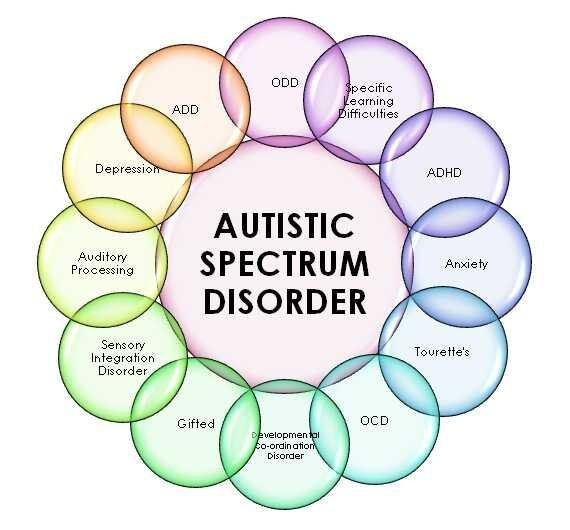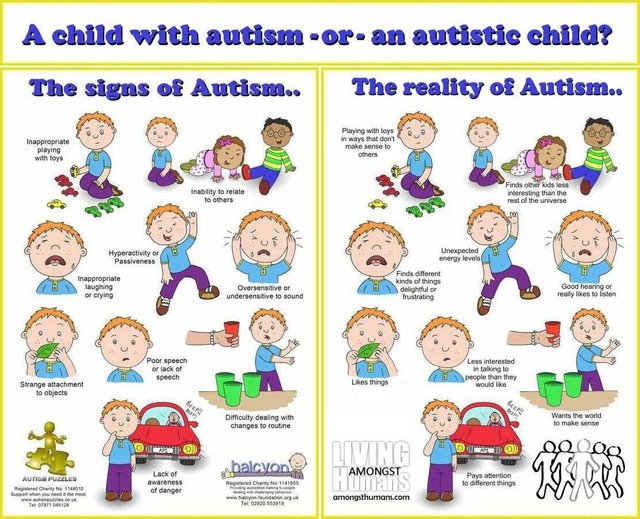AUTISM

Autism spectrum disorder is a serious neurodevelopmental disorder that impairs a child's ability to communicate and interact with others. It also includes restricted repetitive behaviors, interests and activities. These issues cause significant impairment in social, occupational and other areas of functioning.
Autism spectrum disorder (ASD) is now defined by the American Psychiatric Association's Diagnosis and Statistical Manual of Mental Disorders (DSM-5) as a single disorder that includes disorders that were previously considered separate — autism, Asperger's syndrome, childhood disintegrative disorder and pervasive developmental disorder not otherwise specified.
The term "spectrum" in autism spectrum disorder refers to the wide range of symptoms and severity. Although the term "Asperger's syndrome" is no longer in the DSM, some people still use the term, which is generally thought to be at the mild end of autism spectrum disorder.
The number of children diagnosed with autism spectrum disorder is AUTIASM
It's not clear whether this is due to better detection and reporting or a real increase in the number of cases, or both.
While there is no cure for autism spectrum disorder, intensive, early treatment can make a big difference in the lives of many children.

SYMPTOMS
Autism spectrum disorder impacts how a child perceives and socializes with others, causing problems in crucial areas of development — social interaction, communication and behavior.
Some children show signs of ASD in early infancy. Other children may develop normally for the first few months or years of life, but then suddenly become withdrawn or aggressive or lose language skills they've already acquired.
Each child with ASD is likely to have a unique pattern of behavior and level of severity — from low functioning to high functioning. Severity is based on social communication impairments and the restrictive and repetitive nature of behaviors, along with how these impact the ability to function.
Because of the unique mixture of symptoms shown in each child, severity level can sometimes be difficult to determine. However, within the range (spectrum) of symptoms, below are some common ASD actions and behaviors.
Social communication and interaction
- Fails to respond to his or her name or appears not to hear you at times
- Resists cuddling and holding and seems to prefer playing alone — retreats into his or her own world
- Has poor eye contact and lacks facial expression
Doesn't speak or has delayed speech, or may lose previous ability to say words or sentences - Can't start a conversation or keep one going, or may only start a conversation to make requests or label items
- Speaks with an abnormal tone or rhythm — may use a singsong voice or robot-like speech
- May repeat words or phrases verbatim, but doesn't understand how to use them
- Doesn't appear to understand simple questions or directions
- Doesn't express emotions or feelings and appears unaware of others' feelings
- Doesn't point at or bring objects to share interest
- Inappropriately approaches a social interaction by being passive, aggressive or disruptive
Patterns of behavior
Performs repetitive movements, such as rocking, spinning or hand-flapping, or may perform activities that could cause harm, such as head-banging
- Develops specific routines or rituals and becomes disturbed at the slightest change
- Moves constantly
- May be uncooperative or resistant to change
- Has problems with coordination or has odd movement patterns, such as clumsiness or walking on toes, and has odd, stiff or exaggerated body language
- May be fascinated by details of an object, such as the spinning wheels of a toy car, but doesn't understand the "big picture" of the subject
- May be unusually sensitive to light, sound and touch, and yet oblivious to pain
- Does not engage in imitative or make-believe play
- May become fixated on an object or activity with abnormal intensity or focus
- May have odd food preferences, such as eating only a few foods, or eating only foods with a certain texture
- Most children with ASD are slow to gain knowledge or skills, and some have signs of lower than normal intelligence. Other children with ASD have normal to high intelligence — they learn quickly, yet have trouble communicating and applying what they know in everyday life and adjusting to social situations.
A small number of children with ASD are savants — they have exceptional skills in a specific area, such as art, math or music.
As they mature, some children with ASD become more engaged with others and show fewer disturbances in behavior. Some, usually those with the least severe problems, eventually may lead normal or near-normal lives. Others, however, continue to have difficulty with language or social skills, and the teen years can bring worse behavioral problems.
CAUSES
Autism spectrum disorder has no single known cause. Given the complexity of the disorder, and the fact that symptoms and severity vary, there are probably many causes. Both genetics and environment may play a role.
Genetic problems
Several different genes appear to be involved in autism spectrum disorder. For some children, autism spectrum disorder can be associated with a genetic disorder, such as Rett syndrome or fragile X syndrome. For others, genetic changes may make a child more susceptible to autism spectrum disorder or create environmental risk factors. Still other genes may affect brain development or the way that brain cells communicate, or they may determine the severity of symptoms. Some genetic problems seem to be inherited, while others happen spontaneously.
Environmental factors
Researchers are currently exploring whether such factors as viral infections, complications during pregnancy or air pollutants play a role in triggering autism spectrum disorder.
RISK FACTORS
Autism spectrum disorder affects children of all races and nationalities, but certain factors increase a child's risk. They include:
-Your child's sex
Boys are about four times more likely to develop ASD than girls are.
- Family history
Families who have one child with ASD have an increased risk of having another child with the disorder. It's also not uncommon for parents or relatives of a child with ASD to have minor problems with social or communication skills themselves or to engage in certain behaviors typical of ASD. - Other disorders
Children with certain medical conditions have a higher than normal risk of ASD or ASD-like symptoms. Examples of these conditions include fragile X syndrome, an inherited disorder that causes intellectual problems; tuberous sclerosis, a condition in which benign tumors develop in the brain; the neurological disorder Tourette syndrome; and Rett syndrome, a genetic condition occurring almost exclusively in girls, which causes slowing of head growth, intellectual disability and loss of purposeful hand use. - Extremely preterm babies
Babies born before 26 weeks of pregnancy may have a greater risk of ASD.
Parents' ages. There may also be a connection between children born to older parents and ASD, but more research is necessary to establish this link.
WAYOUT OF AUTISM
According to the National Center for Children in Povery (NCCP ), “One in 10 youth has serious mental health problems that are severe enough to impair how they function at home, school, or in the community.” There are no two children with Autism Spectrum Disorders (ASD) or any disorder that affects them the same. So, how do we know how to treat each individual child?
Watching her grow up, we all knew my sister was just a little bit different. She doesn’t like hugs, she hates clothes that are anything but loose, and the littlest of things can stress her out to the point of crying. Later, we found out my little sister had a mix of anxiety, Attention Deficit Hyperactivity Disorder (ADHD) and some Asperger’s tendencies.
She has been teased and made fun of, her dad tries forcing her out of it and it only causes more problems. Some people don’t seem to understand this is not a condition to grow out of and forcing change will only work to exacerbate her challenges. She has both a school counselor and an out of school counselor in which she sees on a regular, and it appears to be helping. Also, art and music have been a great therapeutic benefit along with taking care of the family pets. Some children may require medication, however, there are a number of other therapies that maybe instrumental in help you developing a holistic mental health plan for your child.
Counseling:
Although talk therapy would be relatively impossible for autistic children, a school counselor or a counselor in general is nice to have. A counselor can be another person that a child can trust to help them get through whatever it is that they are dealing with. They can also do other therapies, that do not include talking, while in a session that could help the child learn and grow.
A school counselor should not only be supportive for the child but for the familyof the child also. A child with a disorder is more likely to be teased and bullied, which can both be hard on the child and the family. A counselor should be another person the family can look to for support in times of need.
Animal-assisted therapy:
One kind of therapy that has been showing great improvements in children and adults is animal-assisted therapy. It has helped result in educational, mental, motivational and physical improvements . Children can easily make bonds with animals which teaches them and later helps them form bonds with other people as well.
According to everydayhealth.com “more research is still needed to determine the effects and confirm the benefits of animal-assisted therapy specifically for children with autism, a number of studies have suggested it could help.” Even though the research is not completed yet, studies have shown that it is helping ASD children cope with the struggles of life.
Art and Music:
Art and music is another way for a child with ASD to express themselves. A lot of children don’t know how to express themselves with words but give them music, an instrument or something to draw on and you might just figure out how they are feeling.
According to the American Art Therapy Association , “Art therapy is a mental health profession that uses the creative process of art making to improve and enhance the physical, mental and emotional well-being of individuals of all ages.” Art therapy is benefiting people by helping them manage behaviors, reduce stress, resolve conflicts and improve interpersonal skills.
All of these combined have really helped my little sister and have made her life so much easier. She has formed deep bonds with her animals, spends her free time drawing and coloring and her counselor has been helping her open up to more of the family and become more connected.
Congratulations @abbywealth! You have completed some achievement on Steemit and have been rewarded with new badge(s) :
Click on any badge to view your own Board of Honor on SteemitBoard.
For more information about SteemitBoard, click here
If you no longer want to receive notifications, reply to this comment with the word
STOPGood to know.
Yea
Thanks for reading through
Hello abbywealth.
I write a Steemit service project. You can participate in a beta test if you reply to this message with "@username". Replace "username" with any one steemer username and remove quotations and anythingelse from the reply. Thanks!
Congratulations @abbywealth! You have completed some achievement on Steemit and have been rewarded with new badge(s) :
Click on any badge to view your own Board of Honor on SteemitBoard.
For more information about SteemitBoard, click here
If you no longer want to receive notifications, reply to this comment with the word
STOP